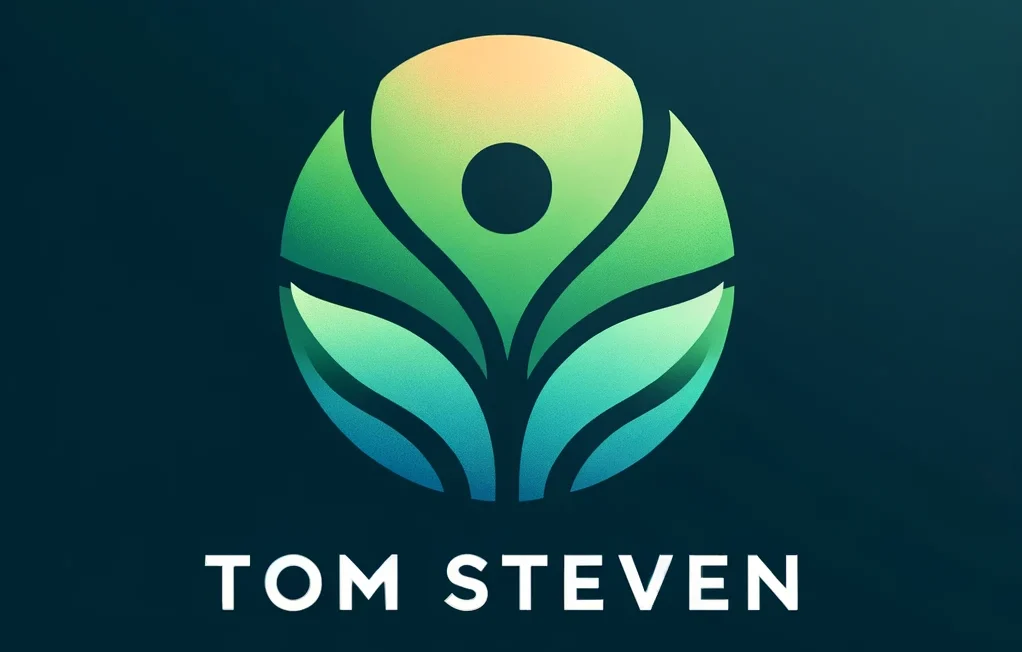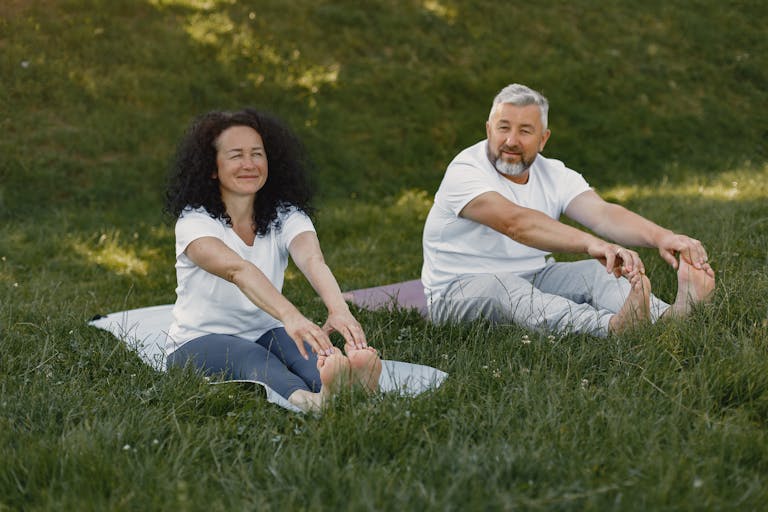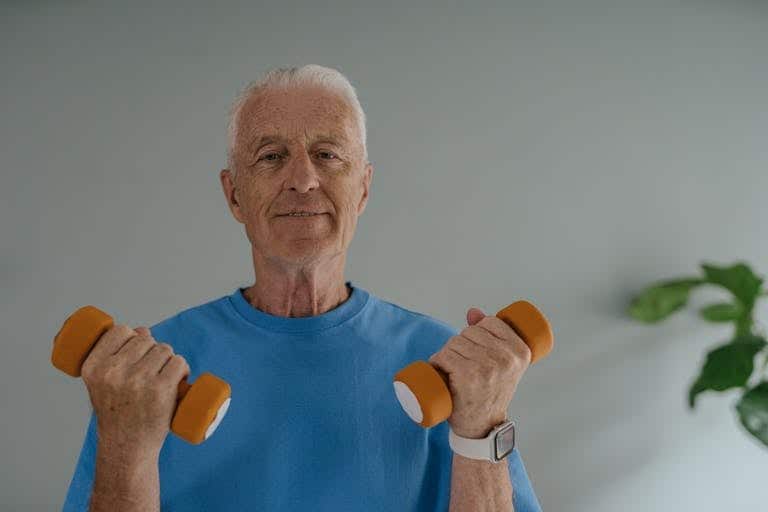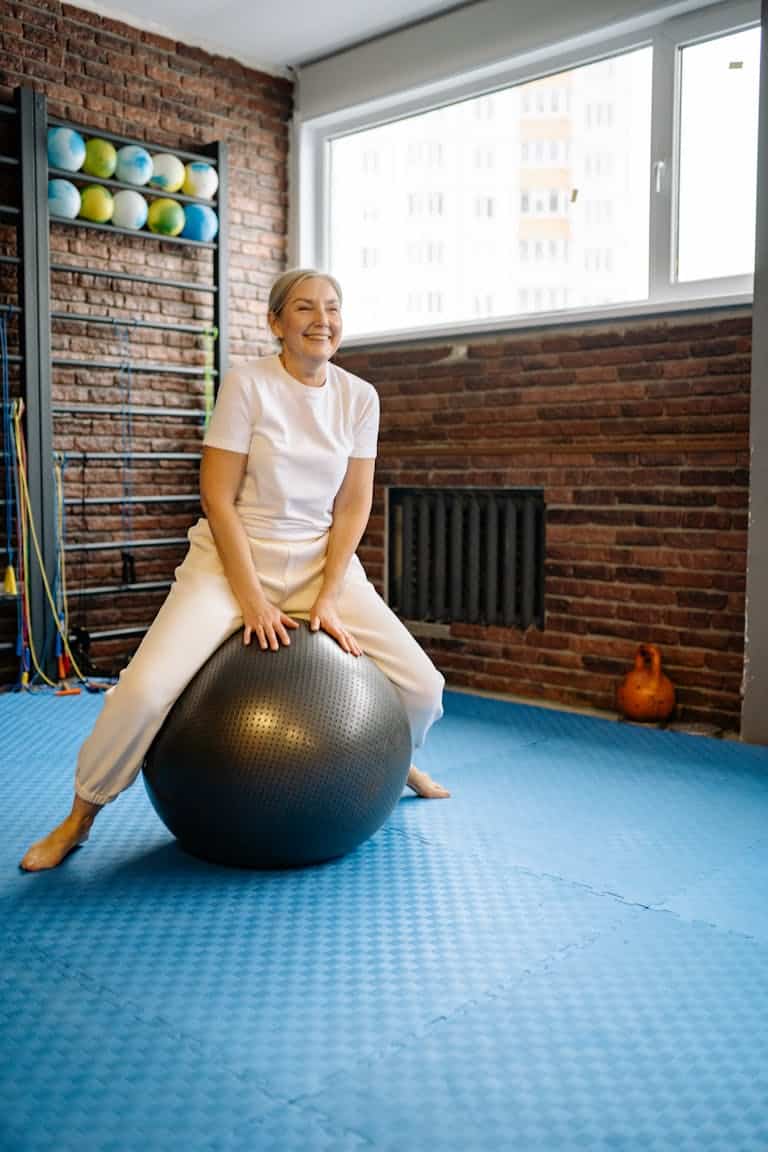Top 5 Foam Rollers for Senior Recovery in 2024
Disclosure: My rankings are meticulously crafted using advanced algorithms that analyze a vast number of customer reviews, assessing everything from product quality and brand reputation to customer service and popular trends. While these rankings are based on my independent evaluations and intended to serve as a helpful starting point for your shopping journey, it’s worth noting that by purchasing through my recommendations, you’ll access the best prices I’ve found. Additionally, I may earn a commission at no extra cost to you, which supports my ability to continue offering valuable insights.
Table of Contents
Introduction:
As we get older, muscle recovery becomes even more essential—whether it’s after exercise or just from the physical demands of everyday life. If you’ve already read my Ultimate Guide to Active Aging and Physical Fitness for Seniors, you’ll know how crucial it is to maintain flexibility and muscle health as we age. One effective way to support this is through foam rolling, a simple yet powerful tool that helps reduce muscle soreness, improve flexibility, and aid in faster recovery.
“It’s not about adding years to your life, but life to your years.” — Anonymous
Foam rollers are especially great for seniors looking to stay active and avoid muscle stiffness. Whether you’re recovering after a walk or following up on Strength Training for Seniors or Chair Yoga for Seniors, using the right foam roller can make all the difference in your recovery. Foam rolling is a must-have for seniors aiming to maintain their mobility and keep doing the things they love.
In this guide, we’ll review the top 5 foam rollers for senior recovery, each carefully selected for its ease of use, effectiveness, and senior-friendly features. Whether you’re in the market for a gentle roller to provide light relief or a firmer one to tackle deep tissue tightness, you’ll find the perfect fit for your needs.
Let’s dive into the options that can help you stay limber and pain-free—because recovery is just as important as staying active.
What to Look for in a Foam Roller for Seniors
When it comes to foam rollers, not all are created equal—especially for seniors. You want to make sure you’re choosing the right one that fits your specific needs. After all, foam rolling can be a fantastic tool to ease muscle soreness, improve flexibility, and speed up recovery. But it’s important to pick one that works for you, especially if mobility is a concern.

Ease of Use
The most important factor is ease of use. Foam rollers should be simple to handle, especially for seniors with limited mobility or joint issues. Look for lightweight, compact rollers that are easy to maneuver around different muscle groups. Rollers that are too bulky or heavy can be a challenge, so you want something that won’t add any extra strain.
Speaking of ease of use, if you’re creating a home gym setup, consider browsing Creating a Budget-Friendly Home Gym for Seniors for more tips on finding senior-friendly equipment that won’t break the bank!
Firmness Levels
Firmness is another crucial factor. Foam rollers come in a variety of densities, and it’s important to find one that matches your comfort level. Softer rollers are fantastic for gentle relief—great if you’re new to foam rolling or if you have sensitive muscles. On the other hand, firmer rollers can offer a more intense, deep tissue massage, which is perfect if you’re looking to release tight knots and work on areas of muscle tension.
“Age is merely the number of years the world has been enjoying you.” — Anonymous
This is a good reminder that no matter your age, there’s a foam roller out there that’s just right for your body’s needs!
If you’re also working on improving your balance or coordination, combining foam rolling with Best Balance Training for Seniors can give you the best of both worlds—mobility and muscle recovery.
Durability
Let’s face it, no one wants to replace their foam roller after just a few months. High-quality foam rollers should be durable enough to withstand regular use without losing their shape. EVA foam is a popular material that’s known for its balance of comfort and durability. You’ll want to invest in a roller that’s going to stick around for the long haul, especially if you plan to use it regularly as part of your recovery routine.
Size
Size matters when choosing a foam roller. Smaller rollers are perfect for targeting specific areas like your calves or upper back, while larger rollers can cover more muscle groups at once. Think about what parts of your body you’ll be focusing on the most. If you’re dealing with chronic lower back pain or larger muscle groups, a longer roller might be more convenient. For smaller areas or travel-friendly options, a more compact roller is the way to go.
Texture
Finally, let’s talk texture. Foam rollers come in two main styles: smooth and textured. Smooth rollers provide a gentler pressure, making them ideal for beginners or those who want to avoid too much intensity. Textured rollers, on the other hand, have ridges or bumps designed to give you a deeper muscle massage. These are great for improving circulation and releasing muscle tension. But keep in mind, textured rollers can feel a bit too intense for first-time users.
Top 5 Foam Rollers for Senior Recovery in 2024
Before we jump into the product recommendations, let’s take a moment to understand why foam rolling is such a game-changer for seniors. Staying active is key, but so is recovery, especially as we age. Whether you’re recovering from a walk, a strength training session, or even a gentle yoga routine, foam rollers can help relieve muscle tension, improve flexibility, and prevent soreness.
Research shows that foam rolling significantly improves range of motion (ROM) and reduces delayed onset muscle soreness (DOMS), which often occurs after physical activity. According to a study by Yanaoka et al. (2020), foam rolling increases ROM regardless of the density of the roller, making it a valuable tool for both light and deep tissue recovery (Yanaoka et al., 2020).
If you’re thinking about pairing foam rolling with other equipment, like joint-friendly workout gear, check out my guide on the Top 5 Joint-Friendly Workout Equipment for Older Adults. Foam rollers also work perfectly alongside yoga and stretching routines. If you’re a fan of flexibility exercises, pairing your roller with one of the Best 15 Yoga Mats for Seniors could really enhance your practice. And for those who enjoy fun, low-impact workouts, foam rolling goes hand-in-hand with Exergames: Combining Fun and Fitness for a Healthier Lifestyle, which offer another great way to stay active without overstraining your muscles.
Now, let’s get into the top five foam rollers that can help you stay flexible, relieve soreness, and feel great after every workout!
1. TRIGGERPOINT PERFORMANCE THERAPY GRID VIBE PLUS Four-Speed Vibrating Foam Roller

- Firmness: Medium-firm, perfect for both light and deep tissue recovery.
- Features: Multi-density foam with a patented design for a targeted massage, four-speed vibration settings.
- Why It’s Great for Seniors: Easy to use for all muscle groups with a stable, solid core for support.
- Pros:
- High versatility with vibration settings.
- Durable and lightweight.
- Effective for deep tissue massage and muscle recovery.
- Cons:
- Higher price point.
- Some users report vibration settings as too intense for sensitive muscles.
- Battery life could be longer.
- Best For: Seniors who want a versatile foam roller for deep tissue recovery and targeted massage.
- Price Range: $99 – $125
- Rating: ★★★★☆ (4.5/5)
- Summary:
The TriggerPoint GRID VIBE PLUS stands out for its innovative vibration feature, which enhances muscle recovery and pain relief. Customers frequently praise its durability and effectiveness in breaking up muscle tightness, but the price and intensity may be drawbacks for those seeking a gentler experience. It’s perfect for active seniors who are used to working with foam rollers and need deeper relief from tension or soreness.
2. OPTP Pro-Roller Soft
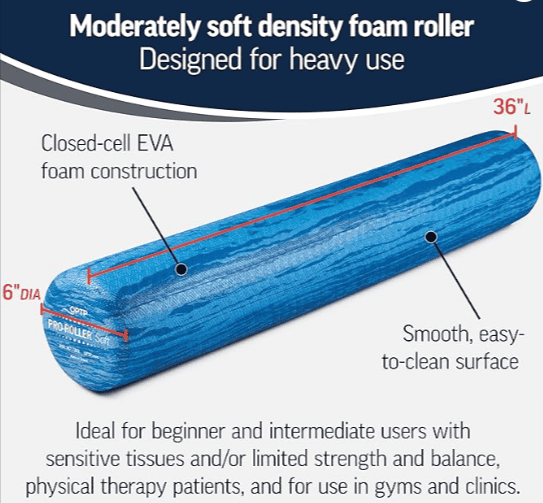
- Firmness: Soft, offering a gentle yet effective massage for seniors with sensitive muscles.
- Features: Closed-cell foam construction, designed for comfort and durability.
- Why It’s Great for Seniors: Ideal for seniors who prefer a less intense massage, particularly those with arthritis or muscle sensitivity.
- Pros:
- Soft and comfortable, making it suitable for long sessions.
- Durable despite its softness.
- Lightweight and easy to handle.
- Cons:
- Not effective for deep tissue massage.
- Some users feel it compresses too quickly over time.
- Best For: Seniors seeking gentle recovery, especially those with sensitive muscles or arthritis.
- Price Range: $30 – $40
- Rating: ★★★★☆ (4.3/5)
- Summary:
The OPTP Pro-Roller is highly praised for being gentle and comfortable, making it ideal for seniors who don’t need intense muscle work. It’s durable for its softness, though some users mention it loses firmness with frequent use. A great option for those looking for a mild, comforting massage rather than a deep tissue experience.
3. Amazon Basics High Density Foam Roller for Exercise and Recovery
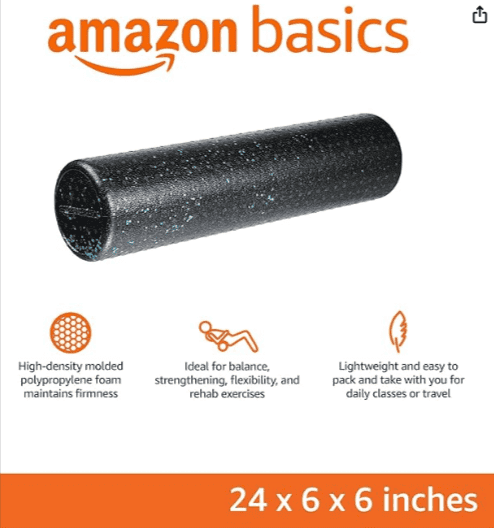
- Firmness: High-density foam for a deeper massage.
- Features: Smooth surface, designed to relieve muscle tightness and soreness.
- Why It’s Great for Seniors: Simple and effective, especially for those looking for more firm pressure during recovery.
- Pros:
- Extremely affordable.
- Long-lasting and retains its shape well.
- Suitable for everyday use and a variety of exercises.
- Cons:
- Too firm for beginners or those with sensitive muscles.
- Lacks the variety of densities or textures seen in more expensive models.
- Best For: Seniors looking for a budget-friendly, durable foam roller with firm pressure.
- Price Range: $15 – $20
- Rating: ★★★★☆ (4.1/5)
- Summary:
The Amazon Basics Foam Roller excels in affordability and durability, making it a popular choice for those who prefer a firm massage. However, it may not be suitable for seniors who require softer or more varied textures. Its straightforward design works well for consistent, everyday use, especially for individuals accustomed to firmer pressure.
4. Yes4All Premium Medium Density Roller

- Firmness: Medium, offering balanced firmness for moderate muscle relief.
- Features: Made from durable EVA foam with a simple design.
- Why It’s Great for Seniors: Offers a good combination of comfort and moderate pressure, suitable for most seniors.
- Pros:
- Affordable and lightweight.
- Provides a good balance between firmness and comfort.
- Versatile for various exercises and muscle groups.
- Cons:
- Durability is not on par with higher-end models.
- Some users report it flattens over time with heavy use.
- Best For: Seniors looking for a cost-effective, all-around foam roller with moderate firmness.
- Price Range: $20 – $30
- Rating: ★★★☆☆ (3.8/5)
- Summary:
The Yes4All roller provides a great middle ground in terms of firmness and comfort, making it a solid choice for seniors who need a moderate level of muscle relief. However, the product’s durability can be an issue, with some reports of it losing shape over time. It’s a cost-effective solution for those who don’t need a premium model.
5. Gaiam Restore Muscle Therapy Foam Roller
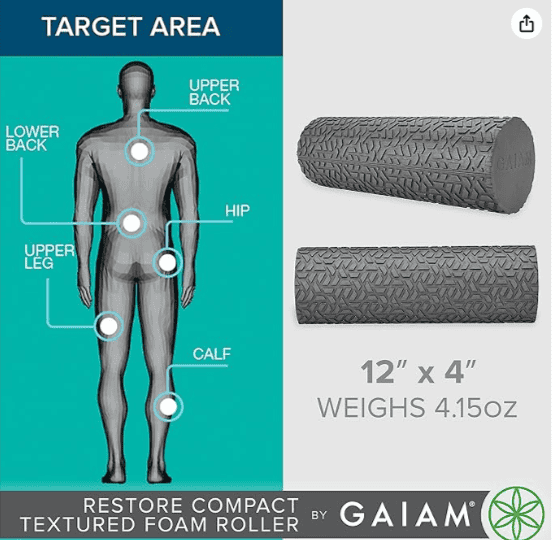
- Firmness: Soft-to-medium, ideal for gentle recovery.
- Features: Textured surface for increased blood flow and muscle relief.
- Why It’s Great for Seniors: The textured surface helps stimulate circulation, which can aid in muscle recovery for seniors.
- Pros:
- The textured surface provides added stimulation for recovery.
- Soft enough for beginners but still provides relief.
- Lightweight and easy to handle.
- Cons:
- The textured surface may be too intense for those new to foam rolling.
- Not as durable as higher-end foam rollers.
- Best For: Seniors who want gentle recovery with the added benefit of increased circulation from the texture.
- Price Range: $25 – $35
- Rating: ★★★★☆ (4.0/5)
- Summary:
The Gaiam Restore Foam Roller is a solid choice for seniors who need gentle recovery and enjoy the benefit of the textured surface for circulation. While some beginners might find the texture too intense, it’s generally well-suited for those looking to improve blood flow and relieve mild muscle soreness. However, it may not last as long as other more durable rollers.
Top 2 Recommendations:
- TRIGGERPOINT PERFORMANCE THERAPY GRID VIBE PLUS Four-Speed Vibrating Foam Roller:
This roller is perfect for seniors who are comfortable with foam rolling and need both light and deep tissue relief. The vibration settings provide an added benefit for muscle recovery, making it a standout option for active seniors. - OPTP Pro-Roller Soft:
For seniors with more sensitive muscles or those looking for a gentler recovery tool, the OPTP Pro-Roller is ideal. It offers comfort and ease of use, without being overly intense, which makes it great for those who don’t need deep tissue massage.
These two options represent the best balance between performance and user needs for seniors looking for either deep tissue recovery or gentler, more comfortable muscle relief.
Benefits of Foam Rolling for Seniors
Foam rolling has so many benefits, especially for seniors looking to maintain their health and mobility. Whether you’re trying to relieve muscle tension, improve flexibility, or just recover faster after exercise, foam rolling can be an essential tool in your fitness routine. Let’s take a closer look at why foam rolling is a must-have for seniors.
Muscle Recovery
One of the biggest perks of foam rolling is its ability to help with muscle recovery. After physical activity, muscles can become tight and sore—something we all want to avoid! Foam rolling helps to reduce muscle soreness and speed up recovery, so you can keep moving without those annoying aches and pains. Studies back this up, showing that foam rolling effectively relieves muscle tension and prevents delayed onset muscle soreness (DOMS), making it a great post-exercise routine for seniors (Pavlović et al., 2022).
If you’re also managing conditions like diabetes, improving muscle recovery can be even more important. For more insights, check out The Importance of Evidence-Based Diabetes Remedies for Effective Management, which highlights how taking care of your body holistically can support long-term health.

Increased Flexibility
As we age, staying flexible is crucial. Regular foam rolling can help improve joint flexibility, which is especially important if you’re dealing with stiffness or limited mobility. By gently massaging the muscles and fascia, foam rolling increases range of motion, making everyday movements easier and more comfortable. Plus, if you’re into yoga or stretching, foam rolling pairs beautifully with a good stretching routine. If you’re looking for ways to enhance flexibility, take a look at Best 15 Yoga Mats for Seniors to Enhance Flexibility.
Improved Circulation
Another key benefit of foam rolling is how it improves circulation. The massaging action helps enhance blood flow to the muscles, which aids in recovery and reduces inflammation. Better circulation means your muscles get the oxygen and nutrients they need, helping you recover faster and feel better overall. It’s also especially useful for seniors looking to stay active without overexerting themselves.
Reduced Tension
Muscle tension and stiffness are common as we age, but foam rolling can help with that, too. Regular rolling sessions can relieve tightness in the muscles, making it easier to stay active and comfortable. Whether it’s back tension from sitting too long or tightness after a workout, foam rolling is an easy way to release that built-up stress.
“The groundwork of all happiness is health.” — Leigh Hunt
It’s true—taking care of your body through foam rolling can lay the foundation for a happier, healthier lifestyle.
Safe at Home
Foam rolling is one of the easiest, most convenient recovery tools you can use right at home. You don’t need a trainer or special supervision, which makes it perfect for seniors. The low-impact nature of foam rolling means it’s gentle on your joints and can be done anytime, whether you’re in front of the TV or winding down after a walk.
How to Use a Foam Roller Safely as a Senior
Foam rolling is a fantastic way to reduce muscle tension and improve flexibility, but like any new exercise or recovery routine, it’s important to use it safely—especially as a senior. With a few precautions, you can enjoy all the benefits of foam rolling without putting unnecessary strain on your body. Here’s how to get started.
Start Slowly
If you’re new to foam rolling, ease into it by starting with a softer roller and gradually building up pressure as your muscles adjust. It’s normal to feel a bit of discomfort at first, but foam rolling should never be painful. You can always work up to a firmer roller once your body is used to it, but there’s no need to rush. The goal is to help your muscles recover, not to push them too hard.
“Take care of your body. It’s the only place you have to live.” — Jim Rohn
This quote is a gentle reminder that starting slowly and listening to your body is crucial for effective recovery.
Target Large Muscle Groups
When foam rolling, it’s best to focus on the larger muscle groups, such as your back, thighs, and calves. These areas are most likely to hold tension, and rolling them gently will provide the most relief. Avoid rolling over smaller areas like joints or the neck, as they require a more delicate approach.
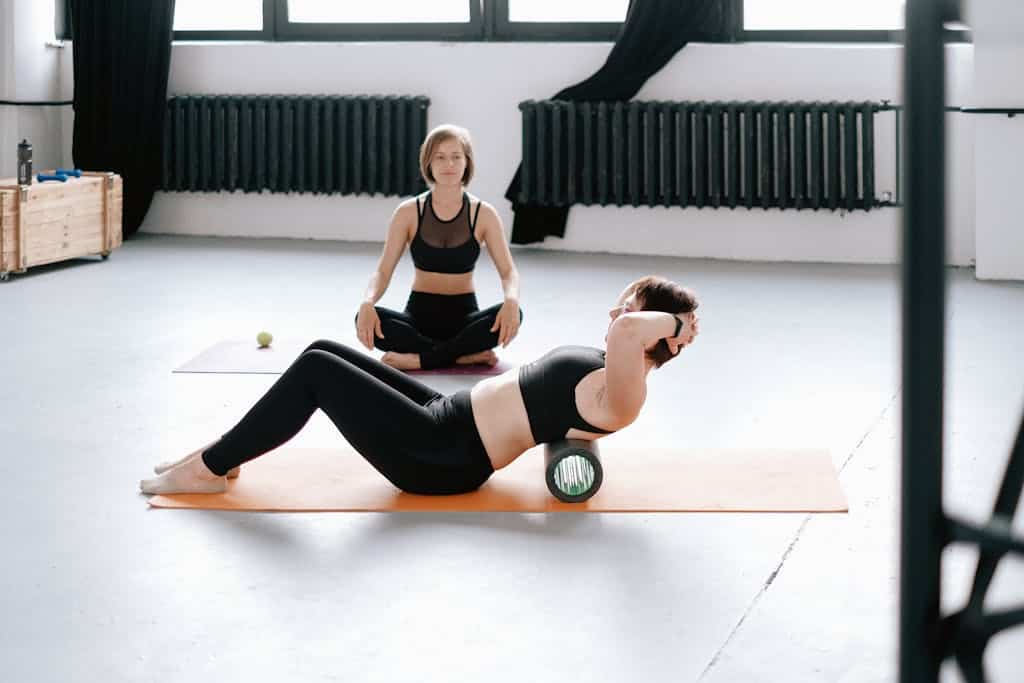
Roll Gently
One of the keys to foam rolling is applying gentle, steady pressure. Rolling too aggressively or directly over bones and joints can lead to injury, especially for seniors who might have more sensitive joints. Focus on the soft tissues, like muscles, and apply pressure gradually. Research by Adamczyk et al. (2020) supports this, showing that proper foam rolling techniques help reduce delayed onset muscle soreness (DOMS) and promote faster recovery by improving circulation and muscle flexibility (Adamczyk et al., 2020). This makes foam rolling an excellent tool for seniors who want a low-impact, effective way to recover after exercise.
Consult a Doctor
As with any new recovery or exercise routine, it’s always smart to consult your healthcare provider before getting started—especially if you have any pre-existing conditions such as diabetes or arthritis. Foam rolling is generally safe, but it’s always best to get personalized advice. For those managing diabetes, you might also want to check out Questions to Ask Your Diabetes Doctor to better understand how to navigate recovery exercises.
Incorporate Stretching
To maximize the benefits of foam rolling, pair it with gentle stretching exercises. Stretching keeps your muscles loose and enhances flexibility. Incorporating foam rolling and stretching together can greatly reduce stiffness and muscle tension. If you need some ideas, check out 10 Essential Exercises for Seniors to Dramatically Improve Balance and Coordination for stretches that complement your foam rolling routine.
Conclusion
Foam rollers are an excellent tool for senior muscle recovery, offering a simple yet effective way to reduce soreness, improve flexibility, and promote faster recovery. Whether you’re looking for gentle relief after a walk or a more intense massage to target deeper muscle tension, there’s a foam roller out there for every senior’s needs. By incorporating foam rolling into your routine, you’ll help your body recover quicker and maintain your mobility, all while staying active and independent.
“Physical fitness is not only one of the most important keys to a healthy body, it is the basis of dynamic and creative intellectual activity.” — John F. Kennedy
As JFK’s words remind us, staying physically active doesn’t just benefit your body—it sharpens your mind, too. With foam rolling, you can maintain both your physical and mental well-being, making it easier to stay healthy and engaged in the activities you love.
As Aristotle said, “We are what we repeatedly do. Excellence, then, is not an act, but a habit.”
By making foam rolling part of your regular routine, you’re building a habit that supports your overall well-being and helps you achieve excellence in maintaining an active lifestyle.
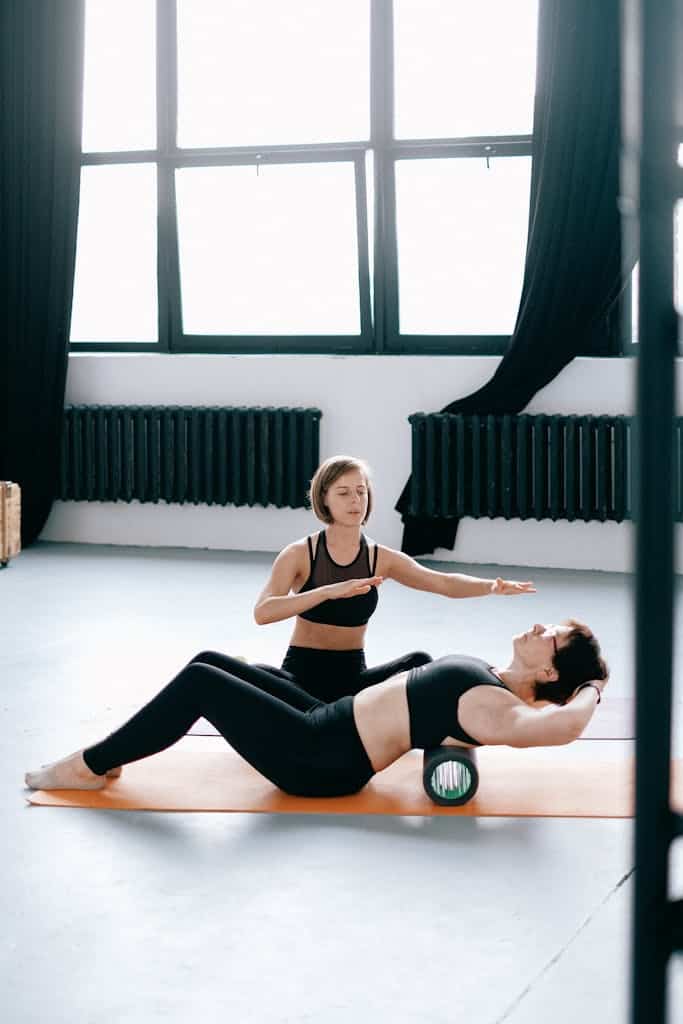
Explore these top foam rollers today and take the first step towards better muscle recovery and a healthier, more active life!
References:
- Yanaoka, T., Yoshimura, A., Iwata, R., Fukuchi, M., & Hirose, N. (2020). The effect of foam rollers of varying densities on range of motion recovery. Journal of Bodywork and Movement Therapies, 26, 64-71. https://doi.org/10.1016/j.jbmt.2020.09.002
- Pavlović, A., Denić, L., & Knežević, O. (2022). Effects of self-massage with foam roller on flexibility and other motor skills: Latest research review. Sport – nauka i praksa. https://doi.org/10.5937/snp12-2-39695
- Adamczyk, J., Gryko, K., & Boguszewski, D. (2020). Does the type of foam roller influence the recovery rate, thermal response and DOMS prevention? PLoS ONE, 15(6). https://doi.org/10.1371/journal.pone.0235195
